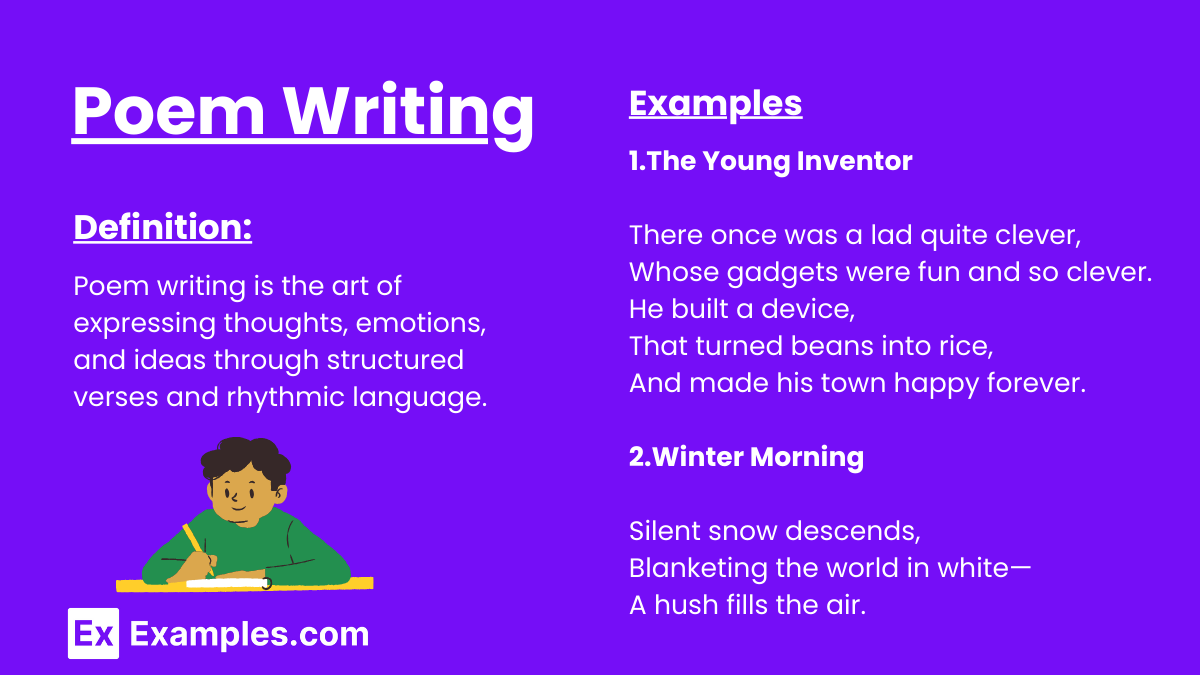Poem Writing
Poem writing is the art of expressing thoughts, emotions, and ideas through structured verses and rhythmic language. It involves the creative use of words to convey deep feelings, vivid imagery, and complex concepts in a condensed form. Poem writing can encompass a wide range of styles and forms, including free verse, sonnets, haikus, and limericks, each with its own set of rules and conventions. This literary practice often employs techniques such as rhyme, meter, alliteration, and metaphor to enhance the aesthetic and emotional impact of the poem.
What is a Poem?
A poem is a form of literary expression that uses rhythm, meter, and often rhyme to convey ideas, emotions, and imagery. Unlike prose, which follows standard grammatical rules and structure, poetry often employs a more freeform style that emphasizes the aesthetic qualities of language and its ability to evoke deeper meanings.
Purpose of a Poem
Poetry serves multiple purposes, enriching both the writer’s and the reader’s experience in various ways. Here are the primary purposes of a poem:
1. Expression of Emotions
Poems are often written to express personal feelings and emotions. Whether it’s love, sorrow, joy, or anger, poetry provides a creative outlet for expressing complex emotions in a concise and powerful way.
2. Telling a Story
Many poems narrate stories, conveying events, characters, and plots in a condensed form. Epic poems, ballads, and narrative poems are examples where storytelling is a key element.
3. Evoking Imagery
Poems use vivid and descriptive language to create pictures in the reader’s mind. Through metaphors, similes, and imagery, poetry brings abstract ideas to life, making them more relatable and impactful.
4. Conveying Ideas and Philosophies
Poetry can explore and convey profound ideas, beliefs, and philosophies. Poets often use their work to reflect on life, human nature, and the world around them, prompting readers to think deeply.
5. Aesthetic Pleasure
The rhythm, meter, rhyme, and overall musicality of poetry provide aesthetic pleasure. The beauty of language, when crafted into poetry, can be enjoyed for its sound and form alone.
6. Cultural and Social Commentary
Poetry often reflects cultural and societal issues, offering commentary on politics, social norms, and current events. Through symbolism and allegory, poets can critique and highlight societal issues.
7. Preservation of History and Culture
Epic poems and ballads have historically been used to preserve history and cultural narratives. They pass down stories, traditions, and values from generation to generation.
What is Poem writing?
Poem writing is the process of creating a poem, which is a piece of literary work that expresses ideas, emotions, or tells a story in a rhythmic and often metaphorical language. Unlike prose, which is straightforward and follows grammatical rules, poem writing involves the use of meter, rhyme, and various poetic devices to evoke an aesthetic and emotional response from the reader.
Poem writing Examples
Here are a few examples of poems in different forms to illustrate various aspects of poem writing, including structure, imagery, figurative language, and rhythm.
Example 1: Sonnet
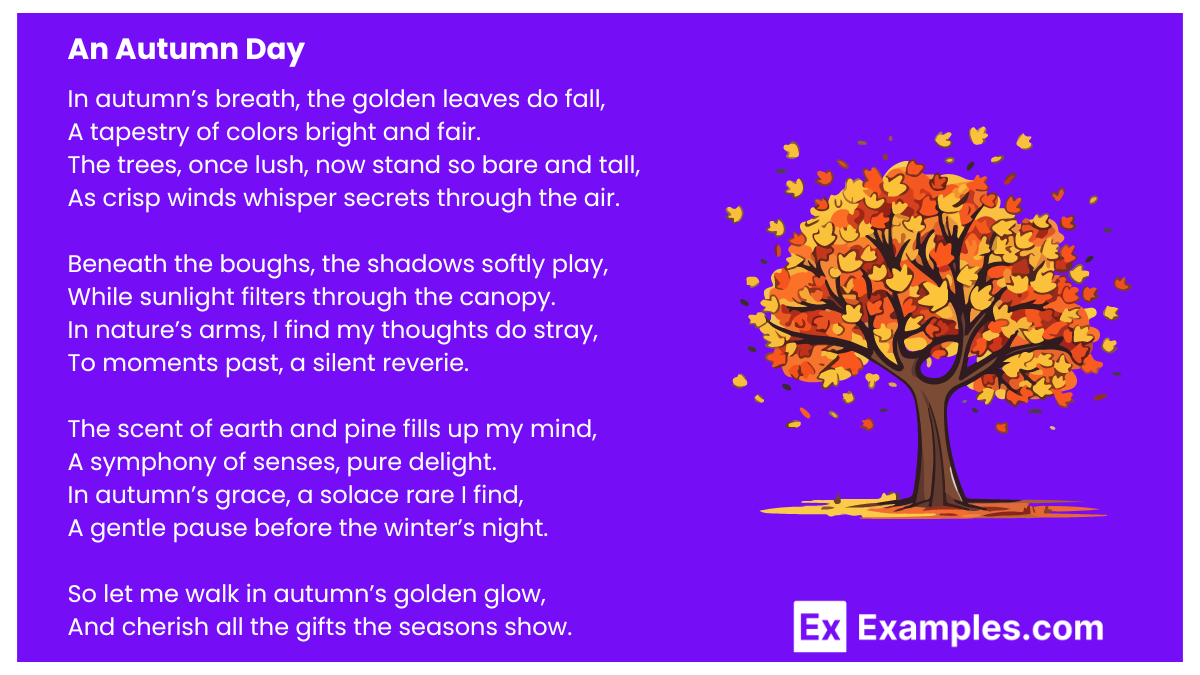
Title: An Autumn Day
In autumn’s breath, the golden leaves do fall,
A tapestry of colors bright and fair.
The trees, once lush, now stand so bare and tall,
As crisp winds whisper secrets through the air.
Beneath the boughs, the shadows softly play,
While sunlight filters through the canopy.
In nature’s arms, I find my thoughts do stray,
To moments past, a silent reverie.
The scent of earth and pine fills up my mind,
A symphony of senses, pure delight.
In autumn’s grace, a solace rare I find,
A gentle pause before the winter’s night.
So let me walk in autumn’s golden glow,
And cherish all the gifts the seasons show.
Example 2: Free Verse
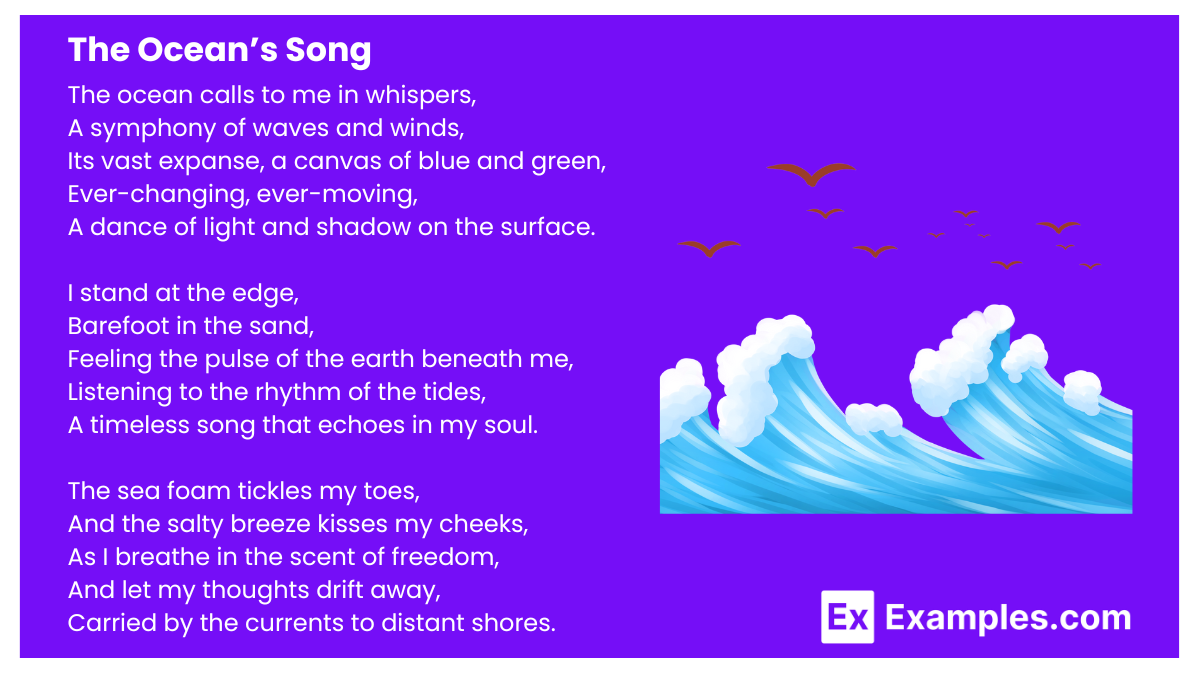
Title: The Ocean’s Song
The ocean calls to me in whispers,
A symphony of waves and winds,
Its vast expanse, a canvas of blue and green,
Ever-changing, ever-moving,
A dance of light and shadow on the surface.
I stand at the edge,
Barefoot in the sand,
Feeling the pulse of the earth beneath me,
Listening to the rhythm of the tides,
A timeless song that echoes in my soul.
The seafoam tickles my toes,
And the salty breeze kisses my cheeks,
As I breathe in the scent of freedom,
And let my thoughts drift away,
Carried by the currents to distant shores.
Example 3: Narrative Poem
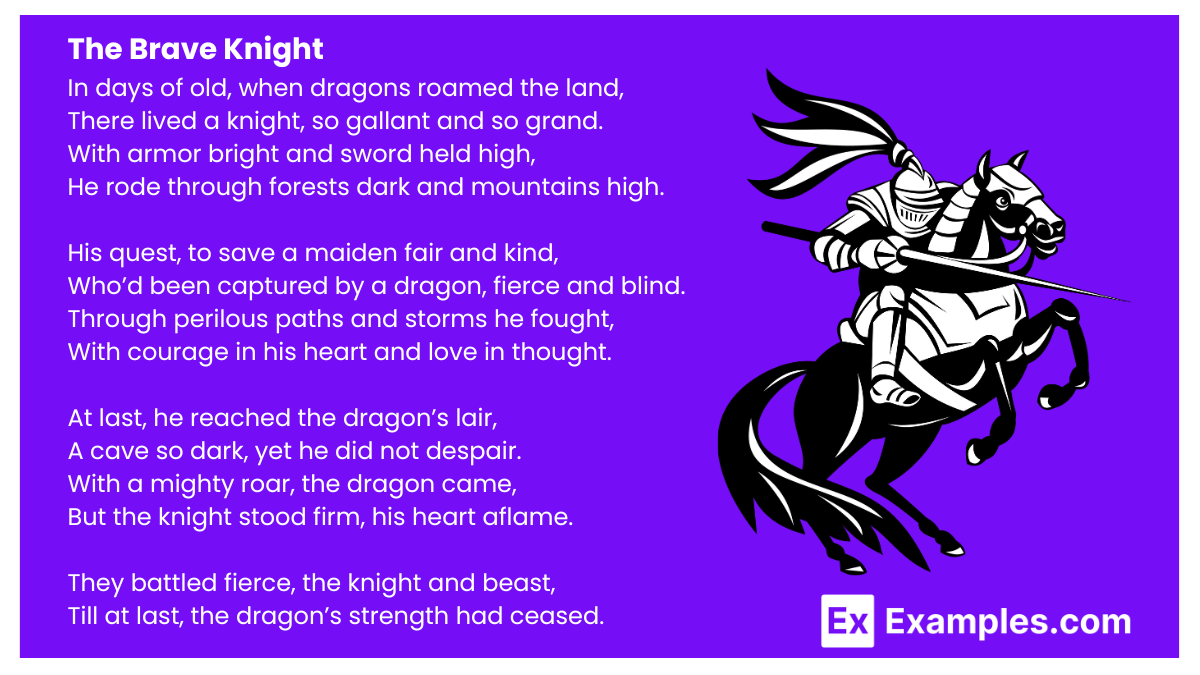
Title: The Brave Knight
In days of old, when dragons roamed the land,
There lived a knight, so gallant and so grand.
With armor bright and sword held high,
He rode through forests dark and mountains high.
His quest, to save a maiden fair and kind,
Who’d been captured by a dragon, fierce and blind.
Through perilous paths and storms he fought,
With courage in his heart and love in thought.
At last, he reached the dragon’s lair,
A cave so dark, yet he did not despair.
With a mighty roar, the dragon came,
But the knight stood firm, his heart aflame.
They battled fierce, the knight and beast,
Till at last, the dragon’s strength had ceased.
He freed the maiden from her chains,
And together they rode through verdant plains.
Example 5: Villanelle
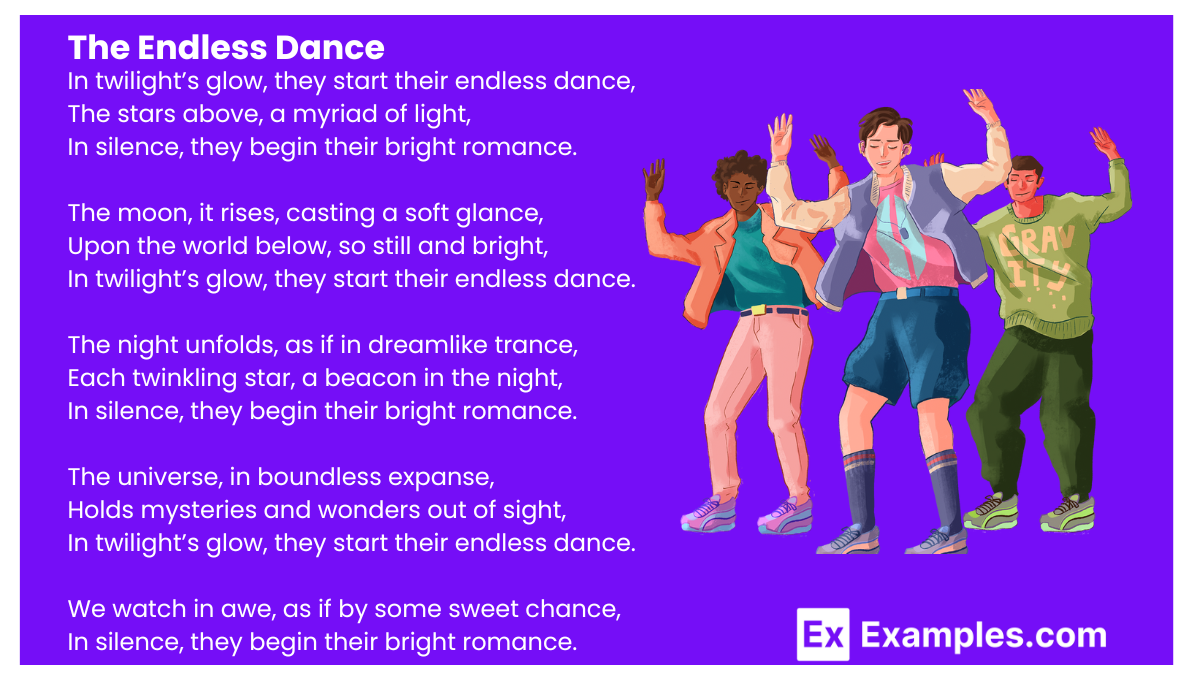
Title: The Endless Dance
In twilight’s glow, they start their endless dance,
The stars above, a myriad of light,
In silence, they begin their bright romance.
The moon, it rises, casting a soft glance,
Upon the world below, so still and bright,
In twilight’s glow, they start their endless dance.
The night unfolds, as if in dreamlike trance,
Each twinkling star, a beacon in the night,
In silence, they begin their bright romance.
The universe, in boundless expanse,
Holds mysteries and wonders out of sight,
In twilight’s glow, they start their endless dance.
We watch in awe, as if by some sweet chance,
To witness such a breathtakingly sight,
In silence, they begin their bright romance.
And so, each night, they weave their vast expanse,
A symphony of dark and light so bright,
In twilight’s glow, they start their endless dance,
In silence, they begin their bright romance.
Key Elements of Poem Writing
- Theme: The central idea or message of the poem. Themes can range from love and nature to political and social issues.
- Structure: The form or pattern of the poem. Common structures include sonnets, haikus, free verse, and limericks.
- Meter and Rhythm: The pattern of stressed and unstressed syllables in a line. This gives the poem a musical quality.
- Rhyme Scheme: The ordered pattern of rhymes at the ends of lines. Common rhyme schemes include ABAB, AABB, and ABCB.
- Imagery: Descriptive language that appeals to the senses, creating vivid pictures in the reader’s mind.
- Figurative Language: Use of metaphors, similes, personification, and other figures of speech to convey deeper meanings.
How to Write a Poem?
Writing a poem involves creativity, observation, and a good understanding of poetic techniques. Here’s a step-by-step guide to help you write a poem.
Step 1: Choose a Theme or Subject
Select a central idea or emotion you want to convey. This could be anything from love, nature, and personal experiences to social issues or abstract concepts.
Step 2: Brainstorm Ideas
Spend some time jotting down words, phrases, and images related to your theme. This freewriting exercise helps in gathering raw material for your poem.
Step 3: Select a Poetic Form
Decide on the structure of your poem. Common forms include:
- Sonnet: 14 lines with a specific rhyme scheme.
- Haiku: A three-line poem with a 5-7-5 syllable pattern.
- Free Verse: No specific rhyme or rhythm, allowing more flexibility.
- Limerick: A five-line humorous poem with a distinct rhythm.
Step 4: Develop a Rhythm and Meter
Consider the flow of your poem. Rhythm and meter can enhance the musicality of your poem. Common meters include iambic pentameter (five pairs of unstressed and stressed syllables).
Step 5: Incorporate Rhyme (if desired)
Choose a rhyme scheme if you want your poem to rhyme. Popular rhyme schemes include ABAB, AABB, and ABCB.
Step 6: Use Figurative Language and Imagery
Enhance your poem with metaphors, similes, personification, and vivid imagery to create deeper meanings and evoke sensory experiences.
Step 7: Write the First Draft
Begin crafting your poem using the ideas, structure, and techniques you’ve chosen. Don’t worry about perfection in this stage; focus on getting your thoughts down.
Step 8: Revise and Edit
Refine your poem by revisiting it multiple times. Pay attention to word choice, line breaks, and overall flow. Read your poem aloud to hear its rhythm and identify areas for improvement.
Step 9: Seek Feedback
Share your poem with others and be open to constructive criticism. This can provide new perspectives and help you improve your work.
Step 10: Finalize Your Poem
Make final adjustments based on feedback and your own revisions. Ensure that your poem effectively conveys your intended emotion or message.
Rules of Poem writing
1. Understand the Purpose
- Define the purpose of your poem. Are you expressing an emotion, telling a story, or conveying a message?
- Ensure every line and word contributes to this purpose.
2. Choose a Form
- Decide on a poetic form that suits your theme and purpose.
- Common forms include sonnets, haikus, free verse, limericks, and narrative poems.
3. Use Imagery
- Employ vivid and descriptive language to create images in the reader’s mind.
- Use sensory details (sight, sound, touch, taste, smell) to enhance the imagery.
4. Employ Figurative Language
- Utilize metaphors, similes, personification, and other figures of speech to add depth and meaning.
- Avoid clichés and strive for originality in your comparisons and descriptions.
5. Consider Sound and Rhythm
- Pay attention to the sound of your poem. Use techniques like alliteration, assonance, consonance, and onomatopoeia to enhance the musicality.
- Create a rhythm through the arrangement of stressed and unstressed syllables (meter).
6. Rhyme Scheme (if applicable)
- If you choose to rhyme, maintain a consistent rhyme scheme throughout the poem.
- Ensure that rhymes feel natural and not forced.
7. Line Breaks and Stanza Structure
- Use line breaks and stanzas to control the flow and pace of your poem.
- Break lines at meaningful points to emphasize words and create impact.
8. Precision and Conciseness
- Be precise in your word choice. Each word should serve a purpose.
- Avoid unnecessary words and phrases. Poetry often values brevity and economy of language.
9. Show, Don’t Tell
- Instead of stating emotions or ideas directly, use imagery and actions to show them.
- Engage the reader’s imagination and allow them to interpret the underlying meanings.
10. Revise and Edit
- Revise your poem multiple times. Focus on clarity, coherence, and impact.
- Read your poem aloud to catch awkward phrasing or rhythm issues.
11. Seek Feedback
- Share your poem with others and be open to constructive criticism.
- Use feedback to refine and improve your work.
12. Maintain Authenticity
- Stay true to your voice and perspective. Authenticity resonates with readers.
- Don’t try to mimic others’ styles too closely; find your unique voice.
How to Write a Short Poem Writing
Writing a short poem can be a delightful and creative way to express your thoughts, emotions, and ideas. Here’s a step-by-step guide to help you craft a concise yet impactful poem.
Choose Your Theme
Decide on the central theme or subject of your poem. This could be an emotion, a moment, a person, or an idea. Keep it simple and focused.
Select a Poetic Form
Pick a poetic form that suits your theme. Some popular short forms include:
Haiku: A three-line poem with a syllable pattern of 5-7-5.
Tanka: A five-line poem with a syllable pattern of 5-7-5-7-7.
Limerick: A five-line poem with a rhyme scheme of AABBA.Brainstorm and Outline
Jot down words, phrases, and images related to your theme. Think about the emotions you want to convey and the message you wish to impart.
Write the First Draft
Start writing your poem based on your outline. Don’t worry about perfection at this stage; just let your thoughts flow.
Use Vivid Imagery and Figurative Language
Enhance your poem with vivid imagery and figurative language such as metaphors, similes, and personification. These elements bring your poem to life and make it more engaging.
Focus on Rhythm and Sound
Pay attention to the rhythm and sound of your poem. Read it aloud to ensure it has a pleasing flow. Consider the use of alliteration, assonance, and consonance to add musicality.
Edit and Revise
Review your poem and refine it. Look for unnecessary words, awkward phrases, and places where the rhythm may be off. Make sure every word serves a purpose.
Add a Strong Ending
Craft a strong, memorable ending that leaves a lasting impression on the reader. This could be a powerful image, a surprising twist, or a profound statement.
Tips for Writing Poetry
1. Read Poetry
Familiarize yourself with various styles and forms by reading a wide range of poems. This exposure will help you understand different techniques and inspire your own writing.
2. Find Inspiration
Draw inspiration from your surroundings, emotions, experiences, and imagination. Anything can be a source of inspiration for your poetry.
3. Use Vivid Imagery
Create strong images in the reader’s mind using descriptive language. Engage the senses—sight, sound, touch, taste, and smell—to make your poem more vivid.
4. Play with Language
Experiment with word choice, rhythm, and sound. Use alliteration, assonance, consonance, and onomatopoeia to enhance the musicality of your poem.
5. Focus on Emotions
Poetry is often a reflection of emotions. Convey your feelings authentically and allow the reader to connect with your words on an emotional level.
6. Be Concise
Poetry often relies on brevity. Choose your words carefully and avoid unnecessary filler. Each word should contribute to the poem’s overall impact.
7. Experiment with Form
Try different poetic forms such as sonnets, haikus, free verse, and limericks. Each form has its own rules and structures that can shape your writing.
8. Use Metaphors and Similes
Comparisons can add depth to your poetry. Metaphors and similes help convey complex ideas and emotions in a relatable way.
9. Edit and Revise
Writing poetry is a process. Don’t be afraid to revise your work multiple times. Read your poem aloud to check its flow and rhythm, and make adjustments as needed.
10. Seek Feedback
Share your poems with others and be open to constructive criticism. Different perspectives can provide valuable insights and help you improve your writing.
11. Write Regularly
Practice makes perfect. Write regularly to develop your skills and find your unique voice. Keep a journal or notebook to jot down ideas, lines, and inspiration.
12. Stay True to Yourself
Write from your heart and stay true to your voice. Authenticity resonates with readers and makes your poetry more powerful.
FAQ’s
How can I improve my poetry?
Read various poets, write regularly, experiment with forms and techniques, and seek constructive feedback from others.
What is the difference between simile and metaphor?
A simile compares two things using “like” or “as,” while a metaphor directly states one thing is another.
How do I use metaphors effectively?
Use metaphors to draw creative, meaningful comparisons that enhance the reader’s understanding and connection to the theme.
What is free verse?
Free verse is poetry without a regular rhyme scheme or meter, allowing for flexible expression.
What is an enjambment?
Enjambment occurs when a sentence or phrase runs over from one line to the next, without terminal punctuation.
Should I follow strict rules in poetry?
Rules can guide, but creativity often shines through bending or breaking them to suit your expressive needs.
What’s the purpose of line breaks?
Line breaks control pacing, emphasize words or phrases, and can create visual interest on the page.
How do I create a good rhythm?
Use meter, repetition, and varied sentence lengths. Reading your poem aloud helps identify natural rhythms.
What is a stanza in poetry?
A stanza is a grouped set of lines within a poem, often separated by a blank line, similar to a paragraph in prose.
What is imagery in poetry?
Imagery involves using descriptive language to create vivid pictures in the reader’s mind, engaging the senses.



